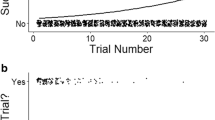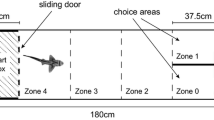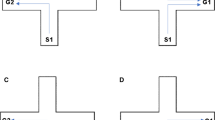Abstract
The development of adaptive responses to novel situations via learning has been demonstrated in a wide variety of animal taxa. However, knowledge on the learning abilities of one of the oldest extant vertebrate groups, Chondrichthyes, remains limited. With the increasing interest in global wildlife tourism and shark feeding operations, it is important to understand the capacities of these animals to form associations between human activities and food. We used an operant conditioning regime with a simple spatial cognitive task to investigate the effects of reinforcement frequency and reward magnitude on the learning performance and memory retention of Port Jackson sharks (Heterodontus portusjacksoni). Twenty-four Port Jackson sharks were assigned one of four treatments differing in reward magnitude and reinforcement frequency (large magnitude–high frequency; large magnitude–low frequency; small magnitude–high frequency; small magnitude–low frequency). The sharks were trained over a 21-day period to compare the number of days that it took to learn to pass an assigned door to feed. Sharks trained at a high reinforcement frequency demonstrated faster learning rates and a higher number of passes through the correct door at the end of the trials, while reward magnitude had limited effects on learning rate. This suggests that a reduction in reinforcement frequency during tourism-related feeding operations is likely to be more effective in reducing the risk of sharks making associations with food than limiting the amount of food provided.




Similar content being viewed by others
Change history
30 June 2020
In the original publication of the article, the Fig. 4 was erroneously published.
References
Amsel A (1958) The role of frustrative nonreward in noncontinuous reward situations. Psychol Bull 55:102
Amsel A (1962) Frustrative nonreward in partial reinforcement and discrimination learning: some recent history and a theoretical extension. Psychol Rev 69:306
Aronson LR, Aronson FR, Clark E (1967) Instrumental conditioning and light-dark discrimination in young nurse sharks. Bull Mar Sci 17:249–256
Barton K (2019) Multi-model inference. R package Version 1.43.17. R Foundation for Statistical Computing, Vienna, Austria
Bouton ME, Woods AM, Todd TP (2014) Separation of time-based and trial-based accounts of the partial reinforcement extinction effect. Behav Proc 101:23–31
Bres M (1993) The behaviour of sharks. Rev Fish Biol Fish 3:133–159
Brown C (2015) Fish intelligence, sentience and ethics. Anim Cogn 18:1–17
Brown C, Laland K, Krause J (2008) Fish cognition and behavior. Wiley, USA
Bruce B, Tasmania H (2015) A review of cage-diving impacts on white shark behaviour and recommendations for research and the industry’s management in New Zealand. Report to the Department of Conservation New Zealand, Hobart, Tasmania
Burgess GH (1998) Diving with elasmobranchs: a call for restraint. Shark News 11:1–4
Burnham KP, Anderson DR (2002) Model selection and multimodel inference: a practical information-theoretic approach. Springer-Verlag, New York
Burnham KP, Anderson DR, Huyvaert KP (2011) AIC model selection and multimodel inference in behavioral ecology: some background, observations, and comparisons. Behav Ecol Sociobiol 65:23–35
Byrnes E, Brown C (2016) Individual personality differences in Port Jackson sharks Heterodontus portusjacksoni. J Fish Biol 89:1142–1157
Byrnes EE, Pouca CV, Brown C (2016a) Laterality strength is linked to stress reactivity in Port Jackson sharks (Heterodontus portusjacksoni). Behav Brain Res 305:239–246
Byrnes EE, Pouca CV, Chambers SL, Brown C (2016b) Into the wild: developing field tests to examine the link between elasmobranch personality and laterality. Behaviour 153:1777–1793
Chivers DP, McCormick MI, Warren DT, Allan BJ, Ramasamy RA, Arvizu BK, Glue M, Ferrari MC (2017) Competitive superiority versus predation savvy: the two sides of behavioural lateralization. Anim Behav 130:9–15
Clua E, Séret B (2010) Unprovoked fatal shark attack in Lifou Island (Loyalty Islands, New Caledonia, South Pacific) by a great white shark, Carcharodon carcharias. Am J Forensic Med Pathol 31:281–286
Corcoran MJ, Wetherbee BM, Shivji MS, Potenski MD, Chapman DD, Harvey GM (2013) Supplemental feeding for ecotourism reverses diel activity and alters movement patterns and spatial distribution of the southern stingray, Dasyatis Americana. PLoS ONE 8:e59235
Dadda M, Bisazza A (2006) Does brain asymmetry allow efficient performance of simultaneous tasks? Anim Behav 72:523–529
Devan BD, Stouffer EM, Petri HL, McDonald RJ, Olds JL (2003) Partial reinforcement across trials impairs escape performance but spares place learning in the water maze. Behav Brain Res 141:91–104
Dill LM (1983) Adaptive flexibility in the foraging behavior of fishes. Can J Fish Aquat Sci 40:398–408
Dobson J (2006) Sharks, wildlife tourism, and state regulation. Tour Mar Environ 3:15–23
Dodson JJ (1988) The nature and role of learning in the orientation and migratory behavior of fishes. Environ Biol Fishes 23:161–182
Edrén SMC, Gruber SH (2005) Homing ability of young lemon sharks, Negaprion brevirostris. Environ Biol Fishes 72:267–281
Ferrari MC, McCormick MI, Allan BJ, Choi RB, Ramasamy RA, Chivers DP (2015) The effects of background risk on behavioural lateralization in a coral reef fish. Funct Ecol 29:1553–1559
FFWCC (2002) Regulations for Feeding Fish, Shark, or other Marine Species [Online]. https://myfwc.com/fishing/saltwater/recreational/fish-feeding/: State of Florida. Accessed 11 Jan 2020
Fuss T, Bleckmann H, Schluessel V (2014a) Place learning prior to and after telencephalon ablation in bamboo and coral cat sharks (Chiloscyllium griseum and Atelomycterus marmoratus). J Comp Physiol A 200:37–52
Fuss T, Bleckmann H, Schluessel V (2014b) Visual discrimination abilities in the gray bamboo shark (Chiloscyllium griseum). Zoology 117:104–111
Fuss T, John L, Schluessel V (2018) Same or different? Abstract relational concept use in juvenile bamboo sharks and Malawi cichlids. Curr Zool. https://doi.org/10.1093/cz/zoy059
Gallagher AJ, Huveneers CP (2018) Emerging challenges to shark-diving tourism. Mar Policy 96:9–12
Girvan JR, Braithwaite VA (1998) Population differences in spatial learning in three-spined sticklebacks. Proc R Soc Lond Ser B: Biol Sci 265:913–918
Gonzalez R, Bitterman M (1967) Partial reinforcement effect in the goldfish as a function of amount of reward. J Comp Physiol Psychol 64:163
Gonzalez R, Potts A, Pitcoff K, Bitterman M (1972) Runway performance of goldfish as a function of complete and incomplete reduction in amount of reward. Psychon Sci 27:305–307
Gonzalez R, Ferry M, Powers AS (1974) The adjustment of goldfish to reduction in magnitude of reward in massed trials. Anim Learn Behav 2:23–26
Graeber RC, Ebbesson SO (1972) Visual discrimination learning in normal and tectal-ablated nurse sharks (Ginglymostoma cirratum). Comp Biochem Physiol A Physiol 42:131–139
Gruber SH, Schneiderman N (1975) Classical conditioning of the nictitating membrane response of the lemon shark (Negaprion brevirostris). Behav Res Methods Instrument 7:430–434
Guttridge TL, Brown C (2013) Learning and memory in the Port Jackson shark, Heterodontus portusjacksoni. Anim Cogn 17:415–425
Guttridge TL, van Dijk S, Stamhuis EJ, Krause J, Gruber SH, Brown C (2013) Social learning in juvenile lemon sharks, Negaprion brevirostris. Anim Cogn 16:55–64
Hammerschlag N, Gallagher AJ, Wester J, Luo J, Ault JS (2012) Don’t bite the hand that feeds: assessing ecological impacts of provisioning ecotourism on an apex marine predator. Funct Ecol 26:567–576
Huveneers C, Rogers PJ, Beckmann C, Semmens JM, Bruce BD, Seuront L (2013) The effects of cage-diving activities on the fine-scale swimming behaviour and space use of white sharks. Mar Biol 160:2863–2875
Johansen E (2013) New shark protection laws in New Caledonia may help boost the economy [Online]. https://newcaledoniatoday.wordpress.com/2013/08/08/new-shark-protection-laws-in-new-caledonia/: New Caledonian Today. Accessed 14 Jan 2020
Kawecki TJ (2010) Evolutionary ecology of learning: insights from fruit flies. Popul Ecol 52:15–25
Kerpelman JP, Himmelfarb S (1971) Partial reinforcement effects in attitude acquisition and counterconditioning. J Pers Soc Psychol 19:301
Lauer D, Estes W (1955) Successive acquisitions and extinctions of a jumping habit in relation to schedule of reinforcement. J Comp Physiol Psychol 48:8
Meyer CG, Papastamatiou YP, Holland KN (2010) A multiple instrument approach to quantifying the movement patterns and habitat use of tiger (Galeocerdo cuvier) and Galapagos sharks (Carcharhinus galapagensis) at French Frigate Shoals, Hawaii. Mar Biol 157:1857–1868
Meyer L, Pethybridge H, Beckmann C, Bruce B, Huveneers C (2019) The impact of wildlife tourism on the foraging ecology and nutritional condition of an apex predator. Tour Manag 75:206–215
Muzio RN, Segura ET, Papini MR (1992) Effect of schedule and magnitude of reinforcement on instrumental learning in the toad, Bufo arenarum. Learn Motiv 23:406–429
Nelson B (2016) S. 3099. https://www.congress.gov/bill/114th-congress/senate-bill/3099/text: Congress
Neuringer AJ (1967) Effects of reinforcement magnitude on choice and rate of responding. J Exp Anal Behav 10:417–424
Newsome D, Rodger K (2008) To feed or not to feed: a contentious issue in wildlife tourism. In: Lunney D, Munn A, Meikle W (eds) Too close for comfort: contentious issues in human-wildlife encounters. Royal Zoological Society of New South Wales, Mosman, New South Wales, pp 255–270
Newsome D, Lewis A, Moncrieff D (2004) Impacts and risks associated with developing, but unsupervised, stingray tourism at Hamelin Bay, Western Australia. Int J Tour Res 6:305
Newton KC, Kajiura SM (2017) Magnetic field discrimination, learning, and memory in the yellow stingray (Urobatis jamaicensis). Anim Cogn 20:603–614
O'Gower A (1995) Speculations on a spatial memory for the Port Jackson shark (Heterodontus portusjacksoni)(Meyer)(Heterodontidae). Mar Freshw Res 46:861–871
Orams MB (2002) Feeding wildlife as a tourism attraction: a review of issues and impacts. Tour Manag 23:281–293
Papastamatiou YP, Cartamil DP, Lowe CG, Meyer CG, Wetherbee BM, Holland KN (2011) Scales of orientation, directed walks and movement path structure in sharks. J Anim Ecol 80:864–874
Portavella M, Vargas JP (2005) Emotional and spatial learning in goldfish is dependent on different telencephalic pallial systems. Eur J Neurosci 21:2800–2806
Pouca CV, Brown C (2018) Food approach conditioning and discrimination learning using sound cues in benthic sharks. Anim Cogn 21:481–492
Pouca CV, Gervais C, Reed J, Michard J, Brown C (2019) Quantity discrimination in Port Jackson sharks incubated under elevated temperatures. Behav Ecol Sociobiol 73:93
Pouca CV, Heinrich D, Huveneers C, Brown C (2020) Social learning in solitary juvenile sharks. Anim Behav 159:21–27
Powter DM, Gladstone W (2009) Habitat-mediated use of space by juvenile and mating adult Port Jackson sharks, Heterodontus portusjacksoni, in eastern Australia. Pac Sci 63:1–14
Rizzari J, Semmens J, Fox A, Huveneers C (2017) Observations of marine wildlife tourism effects on a non-focal species. J Fish Biol 91:981–988
Schatz B, Beugnon G, Lachaud J-P (1994) Time-place learning by an invertebrate, the ant Ectatomma ruidum Roger. Anim Behav 48:236–238
Scheyvens R (1999) Ecotourism and the empowerment of local communities. Tour Manag 20:245–249
Schlaepfer MA, Runge MC, Sherman PW (2002) Ecological and evolutionary traps. Trends Ecol Evol 17:474–480
Schluessel V, Bleckmann H (2005) Spatial memory and orientation strategies in the elasmobranch Potamotrygon motoro. J Comp Physiol A 191:695–706
Schluessel V, Bleckmann H (2012) Spatial learning and memory retention in the grey bamboo shark (Chiloscyllium griseum). Zoology 115:346–353
Schluessel V, Ober C (2018) How to get out of a maze? Stingrays (Potamotrygon motoro) use directional over landmark information when provided with both in a spatial task. Evol Ecol Res 19:619–637
Semeniuk CA, Rothley KD (2008) Costs of group-living for a normally solitary forager: effects of provisioning tourism on southern stingrays Dasyatis americana. Mar Ecol Prog Ser 357:271–282
Sievert C, Parmer C, Hocking T, Chamberlain S, Ram K, Corvellec M, Despouy P (2017) plotly: Create Interactive Web Graphics via ‘plotly. js’. R package version 4.7. 1
Sims D (1996) The effect of body size on the standard metabolic rate of the lesser spotted dogfish. J Fish Biol 48:542–544
Sovrano VA, Dadda M, Bisazza A (2005) Lateralized fish perform better than nonlateralized fish in spatial reorientation tasks. Behav Brain Res 163:122–127
Srinivasan MV (2010) Honey bees as a model for vision, perception, and cognition. Annu Rev Entomol 55:267–284
Stier AC, Geange SW, Bolker BM (2013) Predator density and competition modify the benefits of group formation in a shoaling reef fish. Oikos 122:171–178
Taylor AH, Elliffe D, Hunt GR, Gray RD (2010) Complex cognition and behavioural innovation in New Caledonian crows. Proc R Soc Lond B Biol Sci 277:2637–2643
Team RC (2013) R: A language and environment for statistical computing [Online]. Vienna, Austria. Available: https://www.R-project.org/
Techera EJ (2012) Fishing, finning and tourism: trends in Pacific shark conservation and management. Int J Mar Coast Law 27:597–621
van den Akker K, Havermans RC, Bouton ME, Jansen A (2014) How partial reinforcement of food cues affects the extinction and reacquisition of appetitive responses. A new model for dieting success? Appetite 81:242–252
Vila Pouca C, Gervais C, Reed J, Brown C (2018) Incubation under climate warming affects behavioral lateralisation in Port Jackson Sharks. Symmetry 10:184
Wickham H (2016) ggplot2: elegant graphics for data analysis. Springer, Berlin
Wood S, Scheipl F, Wood MS (2017) Package ‘gamm4’.
Zuur AF, Ieno EN, Elphick CS (2010) A protocol for data exploration to avoid common statistical problems. Methods Ecol Evol 1:3–14
Acknowledgements
We would like to thank the Holsworth Wildlife Research Endowment for funding this project, Joshua Reed and Alyssa Luongo for their help running the trials, and Stephanie Bagala and the staff members of the Sydney Institute for Marine Science (SIMS) for their assistance with animal husbandry.
Funding
This study was funded by the Holsworth Wildlife Research Endowment.
Author information
Authors and Affiliations
Contributions
All authors contributed to the study design. DH and CVP executed the experiments and collected the data. DH ran the statistical analysis and drafted the manuscript. All authors revised the manuscript, gave final approval, and are accountable for accuracy.
Corresponding author
Ethics declarations
Conflict of interest
The authors declare that they have no conflict of interest.
Ethical approval
All procedures performed in studies involving animals were in accordance with the ethical standards of the Flinders University Animal Welfare Committee (E438/16) and the Macquarie University Animal Ethics Committee (ARA2014/003).
Additional information
Publisher's Note
Springer Nature remains neutral with regard to jurisdictional claims in published maps and institutional affiliations.
Electronic supplementary material
Below is the link to the electronic supplementary material.
Rights and permissions
About this article
Cite this article
Heinrich, D.D.U., Vila Pouca, C., Brown, C. et al. Effects of reward magnitude and training frequency on the learning rates and memory retention of the Port Jackson shark Heterodontus portusjacksoni. Anim Cogn 23, 939–949 (2020). https://doi.org/10.1007/s10071-020-01402-2
Received:
Revised:
Accepted:
Published:
Issue Date:
DOI: https://doi.org/10.1007/s10071-020-01402-2




